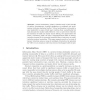Free Online Productivity Tools
i2Speak
i2Symbol
i2OCR
iTex2Img
iWeb2Print
iWeb2Shot
i2Type
iPdf2Split
iPdf2Merge
i2Bopomofo
i2Arabic
i2Style
i2Image
i2PDF
iLatex2Rtf
Sci2ools
101
click to vote
APCSAC
2003
IEEE
2003
IEEE
Latency Improvement in Virtual Multicasting
Virtual multicasting (VMC) combines some of the benefits of caching (transparency, dynamic adaptation to workload) and multicasting (reducing duplicated traffic). Virtual multicasting is intended to save bandwidth in cases of high load, resulting from unpredictable but high demands for similar traffic. However, even in cases where relatively low fractions of traffic are similar (hence offering few opportunities for VMC), introducing VMC can have a disproportionate effect on latency reduction because of the generally beneficial effect of reduction in traffic, including reduced contention. This paper presents results of a study of latency reduction across a range of workloads, illustrating the potential for VMC even in situations where the extent of overlapped traffic is light.
Related Content
| Added | 04 Jul 2010 |
| Updated | 04 Jul 2010 |
| Type | Conference |
| Year | 2003 |
| Where | APCSAC |
| Authors | Philip Machanick, Brynn Andrew |
Comments (0)

